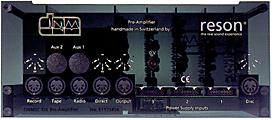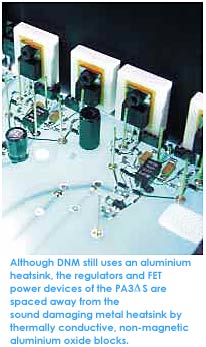This statement is based on the behaviour of the
metal when exposed to a simple constant magnet, i.e. field. However, under
alternating current (AC) conditions (e.g. the intricate workings of a hi-fi amplifier),
these alloys prove to be extremely magnetic,
creating eddy currents which interfere with the all-important audio signal.
Acrylic Cases
 We have deliberately built our amplifiers into cases of high-quality acrylic as it is
a non-conductive material with no magnetic properties. It looks good, too!
We have deliberately built our amplifiers into cases of high-quality acrylic as it is
a non-conductive material with no magnetic properties. It looks good, too!
Closer inspection of any current DNM Design ™ will show that the use of any type
of metal in proximity to the electrical signal path has been virtually eliminated.
Minimal Metal
The
input and output connections of all DNM units use custom-made plastic bodied DIN sockets.
The DIN
connection, although not widely used in domestic audio, has the significant
advantage of lower metal content compared to its RCA equivalent.
In addition,
the DIN connectors used by DNM are a bayonet
locking type. The combination of a small high pressure gold plated
contact surface with the locking bayonet fitment, gives an extremely
high quality, long lasting electrical contact area.
The DNM 3C rotary signal selector switch is fitted with a
plastic shaft and all the fixing screws used in our pre and power amplifiers are
plastic.
Heatsinks
 The only
significant amount of conducting material remaining
in any of our products is the aluminium heatsink used on the DNM power
amplifiers.
The only
significant amount of conducting material remaining
in any of our products is the aluminium heatsink used on the DNM power
amplifiers.
To reduce the influence of magnetic interaction caused by
such a large expanse of metal, we space the output transistors and
regulators away from the heatsink, using aluminium oxide blocks. This
material has no magnetic properties but good thermal conductivity.
This 5mm non-magnetic spacer gives a big increase in clarity and
resolution.
Imagine the loss of quality suffered by large all-metal amplifiers!! Would you choose
to make a camera out of glass and then fail to notice that the film kept fogging?
It is well-nigh impossible to imagine the loss of quality
suffered by large solid metal amplifiers!
Field Effects
Our obsession with stray
electromagnetic fields lies at the heart of every component in the DNM
range - even our cables, both signal and power supply, are designed to reduce
electromagnetic interference as far as possible.
The use of solid core
cable has significant implications for amplifier designs, as it implies
an awareness of the magnetic fields in the cables themselves. After all,
viewed contextually, the signal cables are only an extension of an audio amplifier's
internal circuits. In fact, failure to take account of
magnetic effects has disastrous and irredeemable consequences for sound quality.
End Result
The end result of this new technology is a range of small,
lightweight, audio products, in a market dominated by metal clad monsters.
Does this reduce the perceived value of DNM products? Perhaps, but
with DNM what you are paying for is the sound quality!
To many customers, paying
more for a small plastic box seems strange. All other electronics industries
have been making their products ever smaller and the smaller they become,
the more they cost. Apparently the audio industry is stuck in a time warp!
| |




